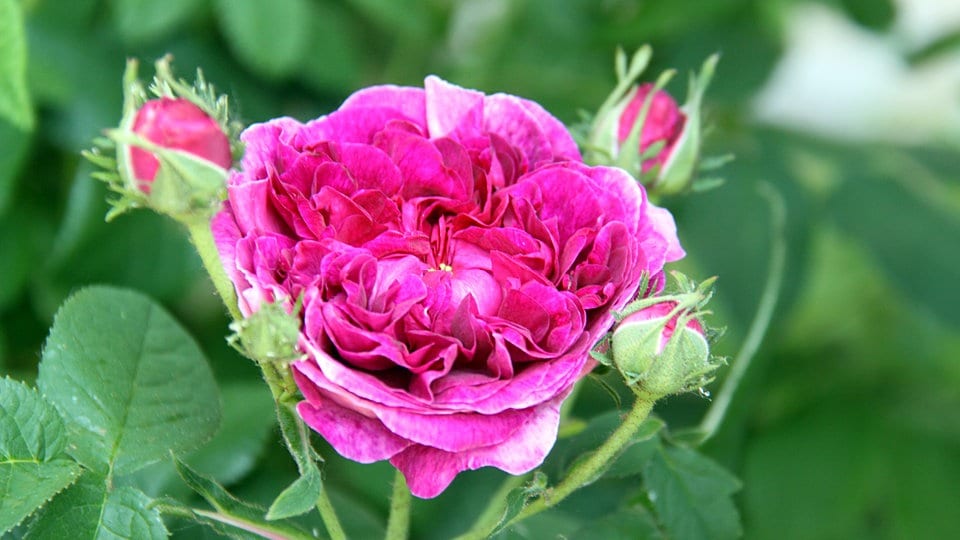Rose varieties that were cultivated in gardens before 1867 are considered historic. The pruning in particular differs from that of modern roses. Garden expert Brigitte Goss provides tips on care and varieties.
Old or historic roses bloom in an exuberant abundance of flowers. Although they only bloom in early summer, they smell indescribably good and are good for use in cooking, drying or preserving.
What are historic roses?
Historical or old roses are roses that were cultivated in gardens before 1867. In 1867, the first tea hybrid was bred and a new era for roses began. After that, old roses were also crossed with these modern roses.
Pruning historic roses
The right time to prune historic roses is after flowering, at the end of June to the beginning of July. Pruning is not absolutely necessary, only when the rose is too old. Pruning in autumn, winter or spring would be completely wrong, because the shoots that are formed this year will produce the flowers for the next flowering summer.
The rose as a cultural asset
Roses have great cultural significance. In ancient times they stood for physical love and fertility, and in Roman times they stood for luxury and extravagance. This is why the rose cult was considered sinful in the first Christian communities. With the decline of the Roman Empire, the rose temporarily lost its importance in art and culture. With the emergence of the cult of the Virgin Mary in the 11th century, this attitude changed completely. The rose returned as a symbol in the Christian faith, especially in the veneration of the Virgin Mary.
Three important historical rose groups:
Rose group Albarose, Rosa alba
There are many secrets surrounding Alba roses. They were probably cultivated in ancient times. Finds show that the old garden roses are particularly strong natural hybrids. They have a great deal of genetic diversity. Our dog rose (Rosa canina) is also present in the genome. All Alba roses are characterized by particularly strong growth and a pleasantly sweet scent. ‘Rosa alba’ came to Central Europe with the Romans and became native. In the Middle Ages, Alba roses were probably cultivated on a larger scale and were found in painting and architecture. During this time they were associated with “innocence” and “purity”. In the 17th and 18th centuries they were extremely popular and in the 19th century there were more than 120 varieties.
The white rose was the symbol of the House of York in the 15th century (Wars of the Roses) and in 1942/43 it was the symbol of the student resistance group “White Rose” (Scholl siblings and others). It is also known as the Luther rose because the reformer chose it as his coat of arms.
Image rights: MDR/Brigitte Goss
- Rosa sulcata ‘Nivea’: white, semi-double and fragrant. The rose grows to more than 1.5 meters high and originally comes from Bulgaria.
- Rosa alba ‘Maiden’s Blush’: delicate pink, lush and intensely sweet-smelling. This rose is suitable for larger pots. Its maximum height is 1.5 meters. It can be trained very well as a climbing plant, even in partial shade.
Image rights: MDR/Brigitte Goss
Rose group Apothecary rose, vinegar rose, Rosa gallica officinalis
Rosa gallica is a rose steeped in history, as its cultivation was ordered by Emperor Charlemagne in the 8th century as a medicinal plant. This rose has been cultivated since 1310 and was the most common garden rose from antiquity to the early modern period. Legend has it that crusaders brought the rose from Syria and the Near East. In times of unpleasant smells, the scented oil extracted from it was highly valued. The petals contain the highest oil content of all rose species. The rose hips have a high ascorbic acid content (3 times as much as lemons). Apothecary roses can become very old and last a whole life. They even tolerate poor, poor soil and partial shade. The flowers last longer there. Brick-red rose hips form by autumn.
Image rights: MDR/Brigitte Goss
- Rosa gallica ‘Officinalis’ (before 1310): red, semi-double, pleasantly scented, 1 to 1.5 meters. It is suitable as a hedge plant.
- Rosa gallica mundi ‘Versicolor’: red and white striped. According to legend, the rose was named after Rosamund Clifford, the lover of Henry II, King of England. It is a mutation of the Apothecary Rose.
- velvet rose; Rosa gallica ‘Tuscany’ (1596): purple-violet, semi-double and slightly fragrant. It is about 1.5 meters high. It is one of the oldest varieties of the Rosa gallica group.
- Rosa gallica ‘Charles de Mills’(after 1700): carmine red, densely filled and very fragrant. It grows up to 1.5 meters tall.
Image rights: MDR/Brigitte Goss
Rose group Damask Rose, Rosa damascena
As the name suggests, Damask roses come from the region around Damascus in the Near and Middle East. These natural hybrids of R. gallica and R. moschata came to Europe with the Crusades in the 13th century. They were extremely popular until the 18th century because until then only Damask rose varieties bloomed into the autumn. Damask roses have an enchanting fragrance. They have therefore been cultivated since ancient times to produce rose oil and rose water. The largest Damask rose cultivation areas have been in Bulgaria since the 17th century (approx. 70 percent of world production). Real rose oil is extremely valuable. 4 tons of flowers are needed for 1 liter of rose oil.
Image rights: MDR/Brigitte Goss
The Damask rose was the medicinal plant of the year 2013. It has anti-inflammatory, antispasmodic and antipyretic effects. In aromatherapy, its essential oil is used to relax the body and soul.
- Rosa damascena ‘Jacques Cartier’ (1842): delicate pink, densely filled, strong fragrance, flowers frequently. A beginner variety that is suitable for pots. It grows up to 1.5 meters tall.
- Rosa damascena ‘Sunshine’ (before 1827): creamy white with carmine red spots. It has a strong scent. This variety is an easy-care beginner variety. It grows to a height of around 1 meter.
- Rosa damascena ‘Rose de Resht’: purple-red, flowers frequently and forms runners. It is suitable for pots and grows to a height of around 1.2 metres.
Image rights: MDR/Brigitte Goss
More about old rose varieties
This topic in the program:MDR THÜRINGEN – The Radio | Radio Garden | 01 June 2024 | 11:00 a.m.





